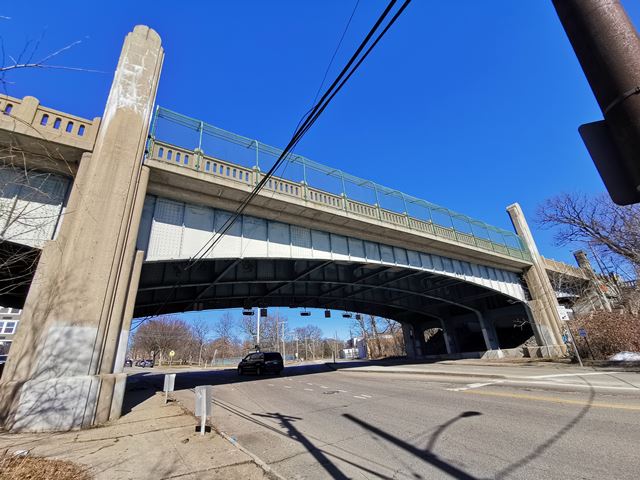We Recommend:
Bach Steel - Experts at historic truss bridge restoration.
McMillan Street Bridge

Primary Photographer(s): Nathan Holth
Bridge Documented: February 25, 2021
Cincinnati: Hamilton County, Ohio: United States
1937 By Builder/Contractor: Kerpen Construction Company of Cincinnati, Ohio and American Bridge Company of New York, New York and Engineer/Design: City of Cincinnati
Not Available or Not Applicable
117.0 Feet (35.7 Meters)
217.0 Feet (66.1 Meters)
44 Feet (13.41 Meters)
3 Main Span(s)
3101231

View Information About HSR Ratings
Bridge Documentation
This bridge is an extremely rare example of a steel rigid-frame bridge, also noted for its outstanding Art Moderne architectural detailing. A nice report with some additional history was produced by History in Your Own Backyard as shown below.
View Archived National Bridge Inventory Report - Has Additional Details and Evaluation
View Historical Article About This Bridge
Above: Historical photo showing bridge construction.
Information and Findings From Ohio's Historic Bridge InventorySetting/Context The bridge carries a 4 lane street and sidewalks over a 4 lane street and sidewalks in an urban setting in Cincinnati. The setting is a mix of industrial and commercial development dating from the 1920s to modern. To the north is a municipal park in the triangular-shaped block formed by intersecting roads. The grade separation carries McMillan Street (a major east-west arterial road) over Reading Road (a major north-south arterial road). The bridge was built in 1937 to replace an 1899 Whipple truss on the same alignment. Physical Description The 3 span, 217'-long, steel rigid frame bridge has built-up variable-depth built-up, riveted girders with integral legs and cantilevered end spans. The main span is 117' long, and the side spans are 50' long each. The 4 ribs have angle stiffeners and riveted cover plates at the haunches where the stresses are greatest in a rigid-frame design. The legs are stiffened by transverse girders with arched soffits. There are transverse stiffeners (diaphragms) with oval-shaped cutouts between the girders, which were designed in the form of Vierendeel girders. It has a concrete deck. The bridge is elaborately finished in the Art Moderne-style with balustrades, stepped concrete pilasters, and oversized pylons that progress in height from the wingwall corners to the piers. The pylons were designed to support stylized aluminum luminaries, which have been removed. Integrity The bridge has the aspects of integrity. The concrete deck was replaced in 1990. Summary of Significance The McMillan Street overpass was built in 1937 by
the City of Cincinnati in the Art Moderne-style that was so popular for
civic works during the 1930s. It is the only pre-1961 steel rigid frame
bridge in the ODOT study (June 2009) and ranks as one of the more
significant bridges of its era from both the engineering and aesthetic
points of view (Criterion C). Justification The bridge has a high level of significance because of its uncommon steel rigid frame design and period aesthetics. Bridge Considered Historic By Survey: Yes |
![]()
Photo Galleries and Videos: McMillan Street Bridge
Bridge Photo-Documentation
Original / Full Size PhotosA collection of overview and detail photos. This gallery offers photos in the highest available resolution and file size in a touch-friendly popup viewer.
Alternatively, Browse Without Using Viewer
![]()
Bridge Photo-Documentation
Mobile Optimized PhotosA collection of overview and detail photos. This gallery features data-friendly, fast-loading photos in a touch-friendly popup viewer.
Alternatively, Browse Without Using Viewer
![]()
Maps and Links: McMillan Street Bridge
Coordinates (Latitude, Longitude):
Search For Additional Bridge Listings:
Bridgehunter.com: View listed bridges within 0.5 miles (0.8 kilometers) of this bridge.
Bridgehunter.com: View listed bridges within 10 miles (16 kilometers) of this bridge.
Additional Maps:
Google Streetview (If Available)
GeoHack (Additional Links and Coordinates)
Apple Maps (Via DuckDuckGo Search)
Apple Maps (Apple devices only)
Android: Open Location In Your Map or GPS App
Flickr Gallery (Find Nearby Photos)
Wikimedia Commons (Find Nearby Photos)
Directions Via Sygic For Android
Directions Via Sygic For iOS and Android Dolphin Browser
USGS National Map (United States Only)
Historical USGS Topo Maps (United States Only)
Historic Aerials (United States Only)
CalTopo Maps (United States Only)


